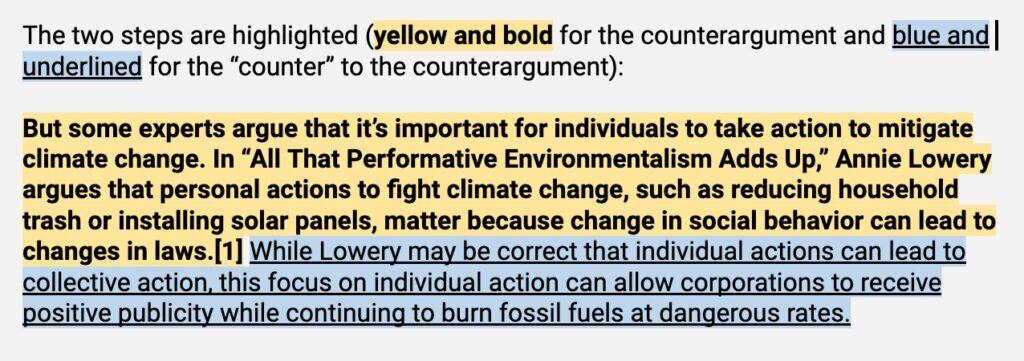Some people are convinced that pineapple belongs on pizza. But half the internet thinks it’s a crime against Italian cuisine.
Some people swear social media has brought the world together. Meanwhile, our grandparents insist it’s ruining family dinners.
In 1633, Galileo faced a bigger version of this dilemma.
Galileo believed that the Earth revolves around the Sun. But the Church said it contradicted scripture. He could have argued aggressively.
But instead, he acknowledged their concern and responded: “The Bible teaches how to go to heaven, not how the heavens go.”

What’s he doing here?
He was presenting a counterclaim in an argumentative essay to the Church’s position while still defending his own.
We do this every day… debating with our parents over curfews, with friends over movies, and with siblings over chores.
Recognizing opposing views while making your case is exactly what a counterclaim in an argumentative essay does.
In this blog, we’ll break down what is a counterclaim in an argumentative essay, where they fit in your writing, and how to use them to make your arguments practically bulletproof.
We’ll learn what is the purpose of a counterclaim in an argumentative essay along with examples.
Let’s dive in.
Key Takeaways
- A counterclaim is an opposing argument and reasoned challenge to your thesis. Presenting it shows you understand multiple perspectives.
- Counterclaims strengthen our essay. It shows critical thinking, research depth, and awareness of complexity.
- The difference between counterclaim and rebuttal: Counterclaim presents the opposition fairly and respectfully. Rebuttal shows why your argument prevails with evidence.
- A solid counterclaim cites experts, institutions, or studies. Avoid vague statements like “some people think…” and instead present specific, logical, and respectful arguments.
- Counterclaims Require a Strategic Rebuttal that acknowledges the counterclaim’s validity, present stronger evidence, and explain why your position still holds.
Definition of a Counterclaim
What is a counterclaim in an argumentative essay?
A counterclaim is an opposing argument to your main thesis.
When you make a claim in an essay, the counterclaim is what someone on the other side might say to challenge it.


Never Worry About AI Detecting Your Texts Again. Undetectable AI Can Help You:
- Make your AI assisted writing appear human-like.
- Bypass all major AI detection tools with just one click.
- Use AI safely and confidently in school and work.
The word “Counterclaim” came from two words:
- Counter comes from the Latin contra, meaning “against.”
- Claim is an assertion or a statement you demand to be true.
Put them together, and you get an “against-statement.” It’s the assertive, reasoned argument that stands against your own.

It’s just as important to know what a counterclaim isn’t as it is to know what it is.
- It’s not just any random opinion you throw in.
- It’s not a weak argument you set up just to knock down.
- And it’s not your own doubts creeping into your essay.
A true counterclaim is a serious, reasonable challenge to your position.
One that makes your essay stronger when you address it properly.
What a Counterclaim Means in Essay Writing
You know what is a counterclaim in an argumentative essay, but you might still be wondering: “Why should I include the other side’s argument? Isn’t that working against me?”
Actually, including a counterclaim adds what’s called the “so what?” factor to your essay.
Understanding what is the purpose of a counterclaim in an argumentative essay reveals why it’s so valuable:
It shows that your argument matters because you’ve thought about other perspectives.
Without it, your essay can feel one-sided. You might be saying, “School uniforms improve focus.” But is that enough? Will everyone automatically agree with you?
Probably not, and your professor might be looking for that deeper analysis.
The purpose of a counterclaim in an argumentative essay includes:
- Demonstrates critical thinking → You’re showing that you’ve considered the bigger picture, not just your own viewpoint.
- Shows research depth → You’ve looked at opposing evidence and understand why it exists.
- Prepares you for real-world debate → In life, work, and discussions, considering other perspectives makes your argument stronger and more credible.
Use this Essay Writer to instantly create balanced outlines with claims, counterclaims, and rebuttals.
It helps make your essay both persuasive and easy to write.
Counterclaim vs Rebuttal: What’s the Difference?
| Aspect | Counterclaim | Rebuttal |
| Definition | Presents the opposing argument fairly and accurately | Your response explaining why your original argument is still stronger |
| Example | Critics argue that school uniforms stifle students’ creativity and self-expression. | However, studies from the Journal of Educational Psychology show that uniforms actually increase focus on academic achievement rather than appearance-based competition |
| Tone | Neutral and respectful. Acknowledge the other side without dismissing it | Confident but respectful. Show your point clearly without attacking the opposition |
| Memory Device | “Here’s what they say.” | “Here’s why I’m still right.” |
Want a step-by-step outline including claims, counterclaims, and rebuttals?
Our AI Essay Writer can generate one for you instantly, so you never miss a critical point in your essay.

Where to Include the Counterclaim in an Essay
You know what is a counterclaim in an argumentative essay and why it’s important.
Now, let’s talk about where it fits. Placement is key to a smooth and logical flow.
- Standard Essay Structure Recap
A typical argumentative essay flows like this:
Intro → Claim → Evidence → Counterclaim → Rebuttal → Conclusion
Example:
Topic: Should schools require uniforms?
- Intro: Schools aim to create a focused learning environment.
- Claim: Uniforms improve student concentration and reduce distractions.
- Evidence: A 2020 study found that schools with uniforms had higher test scores.
- Counterclaim: Critics argue that uniforms stifle creativity and self-expression.
- Rebuttal: However, research shows that uniforms help students focus on academics rather than appearance-based competition.
- Conclusion: Requiring uniforms supports both learning and equality, outweighing concerns about self-expression.
- Placement Options: Before or After Main Argument
You have two choices for where to place your counterclaim and rebuttal.
Option 1: After Your Main Arguments (The Recommended Method)
This is the most common and easiest approach, especially for beginners. You first build a strong case for your thesis over several paragraphs.
Then, you introduce the counterclaim.
This sequence allows you to firmly establish your position in the reader’s mind first.
It feels logical, you’re laying your foundation before defending it from attack. It’s also much easier to organize.
- Example Structure:
- Intro: Thesis – “School uniforms create a better learning environment.”
- Body Paragraph 1: Evidence that uniforms reduce bullying.
- Body Paragraph 2: Evidence that uniforms improve focus.
- Body Paragraph 3: Counterclaim: “However, critics argue uniforms stifle student individuality.” → Rebuttal: “But studies show… [refute the counterclaim].”
- Conclusion
Option 2: Before Your Main Arguments (The Advanced Power Move)
This is a technique for tackling well-known objections head-on.
You address the biggest counterclaim right after your introduction, before you even present your own supporting points.
It immediately tackles the “elephant in the room.” It shows confidence and can make your subsequent arguments seem even more powerful because you’ve already cleared a major hurdle.
It’s highly effective for controversial topics.
- Example Structure:
- Intro: Thesis – “Universal basic income is a viable economic policy.”
- Body Paragraph 1: Counterclaim: “The most common objection to UBI is that it discourages people from working.” → Rebuttal: “However, pilot programs in…[refute it].”
- Body Paragraph 2: Evidence that UBI reduces poverty.
- Body Paragraph 3: Evidence that UBI boosts entrepreneurship.
- Conclusion
Now, if you’re wondering: “What if my counterclaim is stronger than my own argument?”
This is a sign that you might need to:
- Find stronger evidence to support your original thesis.
- Refine your thesis to be more specific and defensible.
- Or, in some cases, change your position entirely.
Good writing is a process of discovery, and it’s okay if your initial opinion evolves as you learn more. A strong essay is about presenting the best argument, not just being “right.”

Also Read: Where to Address Counterarguments
- Transition Phrases to Introduce a Counterclaim
Smooth transitions make your counterclaim professional and credible. Use these depending on tone and context:
Neutral Introduction
- Some argue that…
- An alternative perspective suggests…
- Critics contend that…
Acknowledging Strength
- Admittedly…
- It’s true that…
- A valid concern is…
Academic Formality
- Opponents of this view maintain that…
- Skeptics question whether…
- Alternative research indicates…
Avoid vague phrases like “Some people think…” or “Others believe…”. Be specific about who holds the opposing view. It adds authority and clarity.
How to Write an Effective Counterclaim
Follow this 3-step process to write an effective counterclaim:
Step 1: Research Legitimately Strong Opposition
Start by looking for credible academic sources that disagree with your position.
Don’t settle for weak arguments, if you can only find flimsy points, you haven’t done enough research.
Quality Check: Can you present the counterclaim so convincingly that someone who holds that view would say, “Yes, that’s exactly what I believe”? If yes, you’ve found a solid counterclaim.
Step 2: Present the Counterclaim Fairly
Your counterclaim should be accurate and respectful, not dismissive.
- Weak Example: Some crazy people think homework should be banned.
- Strong Example: Education researchers like Dr. Alfie Kohn argues that homework can increase student stress without improving learning outcomes, citing studies from Finland’s homework-light education system.
Notice the difference? One mocks the opposition, the other acknowledges it with credibility and evidence.
Step 3: Craft a Stronger Rebuttal
Once you’ve presented the counterclaim, respond strategically:
Formula:
- Acknowledge the counterclaim’s validity.
- Present stronger evidence supporting your claim.
- Explain why your position still prevails.
Also Read: How To Write an Informative Essay (with Examples & Tips)
If you struggle to word your counterclaim or rebuttal, use AI Chat to draft them from scratch.
Need a counterclaim for school uniforms, or social media effects? Ask AI Chat.
Need a rebuttal for climate change policies? AI Chat can help.
It turns rough ideas into clear, structured, and persuasive arguments in minutes.

Counterclaim Examples
Example 1: Smartphones in the Classroom
| Aspect | Content |
| Essay Topic | Should smartphones be allowed in classrooms? |
| Thesis Position | Smartphones should be banned in classrooms to minimize distraction. |
| Weak Counterclaim | “Some people think phones are good for learning.” → (Easy to dismiss) |
| Strong & Credible Counterclaim | “Proponents of smartphone integration, such as Dr. Monica Bulger of the Joan Ganz Cooney Center, argue that these devices can be powerful educational tools. They point to the potential of educational apps, the ability for students to conduct instant research, and the importance of developing digital literacy skills that are essential in the modern workplace.” → (Cites a specific expert and institution, presents clear and logical points, and is stated respectfully.) |
| Effective Rebuttal | “While the potential for enhanced learning is a compelling argument, practical studies of classroom implementation suggest the distractions outweigh the benefits. Research from the London School of Economics found that schools which instituted phone bans saw a 6.4% improvement in test scores, attributing the gain to increased student focus, more face-to-face interaction, and a reduction in cyberbullying during school hours. This suggests that until structured digital literacy curricula can fully mitigate these distractions, a ban is the most effective policy for core learning environments.” |
Example 2: College Tuition Debate
| Aspect | Content |
| Essay Topic | Should college tuition be free? |
| Thesis Position | Yes, public college and university should be tuition-free. |
| Strong Counterclaim | “Fiscal conservatives and budget analysts contend that free college tuition would place a massive burden on taxpayers. According to estimates from the U.S. Department of Education, a nationwide free-tuition program could cost approximately $79 billion annually, potentially requiring significant tax increases or cuts to other essential public services like infrastructure and healthcare.” → (It uses a specific, authoritative source (the DoE) and provides a concrete number ($79B)) |
| Effective Rebuttal | “This concern about cost is valid, but it often takes a short-term view. Economic analyses of nations with free or heavily subsidized higher education, such as Germany and Norway, demonstrate that the increased tax revenue from a higher-educated, higher-earning workforce typically offsets the initial educational investment within 8-12 years. Furthermore, a more educated populace correlates with lower crime rates and reduced reliance on social welfare programs, creating long-term societal savings that justify the upfront expenditure.” |
Give our AI Detector and Humanizer a try in the widget below!
Final Thoughts
Learning what is a counterclaim in an argumentative essay makes our thinking more clear and convincing.
Students who avoid counterclaims avoid tough conversations in real life.
But those who face them become the people others listen to, because they’ve thought through all sides.
Your next essay is the perfect chance to practice.
Find the strongest challenge to your thesis, present it fairly, then show why your argument still works.
Do this, and your position will become clearer and more convincing, even to yourself.
Before you start, use Undetectable AI’s Essay Writer and AI Chat to brainstorm strong counterclaims and refine your arguments without losing originality.
That’s the real purpose of a counterclaim in an argumentative essay. It doesn’t just make your essay stronger, it makes your thinking stronger.
Start creating clear, convincing essays with Undetectable AI today.
